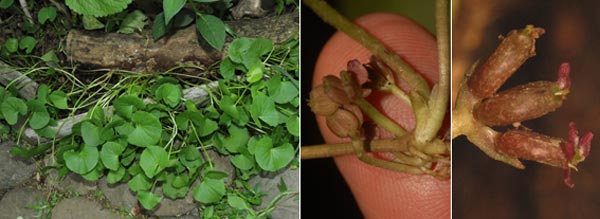 |
QUICK SEARCH
MO PROJECTS:
Africa
Asia/Pacific
Mesoamerica
North America
South America
General Taxonomy
Photo Essays
Training in Latin
America
MO RESEARCH:
Wm. L. Brown Center
Bryology
GIS
Graduate Studies
Research Experiences
for Undergraduates
Imaging Lab
Library
MBG Press
Publications
Climate Change
Catalog Fossil Plants
MO DATABASES:
W³MOST
Image Index
Rare Books
Angiosperm
Phylogeny
Res Botanica
All Databases
INFORMATION:
What's New?
People at MO
Visitor's Guide
Herbarium
Jobs & Fellowships
Symposium
Research Links
Site Map
Search
|
Draft Treatments | Guidelines | Checklist | Citing | Editors The Cutting EdgeVolume XXVIII, Number 3, July 2021News and Notes | Leaps and Bounds | Germane Literature | Season's Pick | Annotate your copy | Global Range Extensions This season's featured species is Centella erecta (L. f.) Fernald (Apiaceae). Or is it?
This plant (vouchered by Hammel 27831, CR) showed up at the edge of Manual co-PI Barry Hammel's garden, where he was waiting for it to flower and wondering how Viola guatemalensis W. Becker, or some other sp. of Viola, had found its way there. When he saw the tiny purplish structures arising from the stolons, at the base of leaves, he wondered if they might be cleistogamous flowers, or perhaps only leaf buds. None of the above! They turned out to be full-blown flowers and fruits of some Apiaceae or Araliaceae (e.g., Hydrocotyle). After arguing with the keys in our just-published volume containing those taxa (authored and co-authored, respectively, by Manual bastion Francisco Morales), Hammel decided his plant had to be Centella and shoved it into C. erecta, in spite of our key and description specifying the leaf blades of that sp. as "ovado-acorazonadas," while these are clearly "reniforme-acorazonadas." Centella erecta has been collected few times in Costa Rica, perhaps accounting for the lack of variation in our leaf-shape description. On the other hand, the leaves of Hammel's plant look much like those of C. asiatica (L.) Urb., as seen in TROPICOS and elsewhere. We are not currently privy to any taxonomic treatment in which the two aforementioned Centella spp. have been distinguished, so offer these photos to our readers (see more of this plant on Hammel's Flickr site or on Tropicos), in case anyone wants to revise the genus! For the time being, we have adjusted the online version of the Manual Apiaceae treatment to accommodate the additional leaf shape (and locality) for C. erecta.
|
© 1995-2025 Missouri Botanical Garden, All Rights Reserved
4344 Shaw Blvd.
St. Louis, MO 63110
(314) 577-5100
Technical Support
